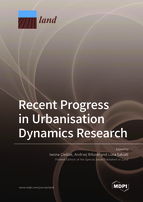Recent Progress in Urbanisation Dynamics Research
A special issue of Land (ISSN 2073-445X). This special issue belongs to the section "Urban Contexts and Urban-Rural Interactions".
Deadline for manuscript submissions: closed (5 October 2021) | Viewed by 59065
Special Issue Editors
Interests: spatial analysis; GIS; urban planning; urban sustainability; urban development; urbanism; city planning; spatial planning; sustainable development
Special Issues, Collections and Topics in MDPI journals
Interests: spatial planning; urban analysis; optimization of urban space; spatiotemporal analysis; fuzzy set theory; changes in land use and land cover
Special Issues, Collections and Topics in MDPI journals
Interests: climate change; desertification; land-use; sustainable agriculture; urban sprawl; urban and rural geography
Special Issues, Collections and Topics in MDPI journals
Special Issue Information
Dear Colleagues,
This Special Issue is dedicated to urbanization, which is observed every day, as well as the methods and techniques of monitoring and analyzing this phenomenon. In the 21st century, urbanization has gained momentum, and the awareness of the significance and influence of this phenomenon on our lives make us take a closer look at it not only with curiosity, but also great attention. There are numerous reasons for this, among which the economy is of special significance, but it also has many results, namely, economic, social, and environmental. First of all, it is a spatial phenomenon, as all of the aspects can be placed in space. We would therefore like to draw special attention to the results of urbanization seen on the Earth's surface and in the surrounding space. The urbanization–and relation seems obvious, but is also interesting and multi-layered. The development of science and technology provides a lot of new tools for observing urbanization as well as the analyses and inference of the phenomenon in space. In the presented Special Issue, we would like to include manuscripts that present the latest trends of research that use experience in the widely-understood geography of the area. Contributions dealing with various aspects of in urbanization dynamics processes underway throughout the world are desired, including, but not limited to the following: spatial changes in city structures; the challenges of infrastructure provision; the loss of agricultural land; creating new spatial forms; and environmental, economic, and social changes. This Special Issue is focused on multidisciplinary phenomenon, i.e., urbanization, with the use of the satellite and photogrammetric observation technologies and GIS analyses.
Prof. Dr. Iwona Cieślak
Prof. Dr. Andrzej Biłozor
Prof. Dr. Luca Salvati
Guest Editors
Manuscript Submission Information
Manuscripts should be submitted online at www.mdpi.com by registering and logging in to this website. Once you are registered, click here to go to the submission form. Manuscripts can be submitted until the deadline. All submissions that pass pre-check are peer-reviewed. Accepted papers will be published continuously in the journal (as soon as accepted) and will be listed together on the special issue website. Research articles, review articles as well as short communications are invited. For planned papers, a title and short abstract (about 100 words) can be sent to the Editorial Office for announcement on this website.
Submitted manuscripts should not have been published previously, nor be under consideration for publication elsewhere (except conference proceedings papers). All manuscripts are thoroughly refereed through a single-blind peer-review process. A guide for authors and other relevant information for submission of manuscripts is available on the Instructions for Authors page. Land is an international peer-reviewed open access monthly journal published by MDPI.
Please visit the Instructions for Authors page before submitting a manuscript. The Article Processing Charge (APC) for publication in this open access journal is 2600 CHF (Swiss Francs). Submitted papers should be well formatted and use good English. Authors may use MDPI's English editing service prior to publication or during author revisions.
Keywords
- urban analyses
- urban sprawl
- environmental changes
- land management
- change land use
- land cover
- suburbanization
- GIS analyses
- remote sensing data
Related Special Issue
- Recent Progress in Urbanisation Dynamics Research Ⅱ in Land (6 articles)








